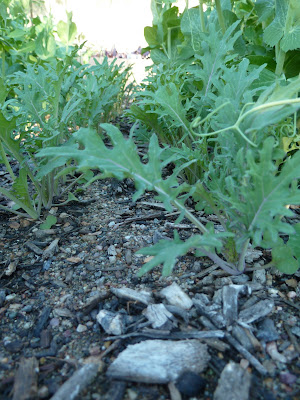
Lesson 1: Radishes are easy
 They germinate quickly, they are harvestable size in around 3 weeks (carrots don't even germinate for 2 weeks) and they don't take up that much space. All of these characteristics are great for a plant growing in an urban garden where space is at a premium. The lesson to take home from this for us is that we don't need to dedicate a growing bed to radishes. They grow so quickly that we can inter-plant radishes with nearly any other crops. By the time even a moderately quick growing plant is large enough to cause a problem, the radishes will be completely harvested.
They germinate quickly, they are harvestable size in around 3 weeks (carrots don't even germinate for 2 weeks) and they don't take up that much space. All of these characteristics are great for a plant growing in an urban garden where space is at a premium. The lesson to take home from this for us is that we don't need to dedicate a growing bed to radishes. They grow so quickly that we can inter-plant radishes with nearly any other crops. By the time even a moderately quick growing plant is large enough to cause a problem, the radishes will be completely harvested.Lesson 2: Greens are amazing in the Phoenix winter

 Above are pictures of our kale and escarole. Both did quite well and we plan to plant more of both of them next fall. Many of our greens were harvested multiple times and recovered quickly. The arugula set the record with 5 cuttings.
Above are pictures of our kale and escarole. Both did quite well and we plan to plant more of both of them next fall. Many of our greens were harvested multiple times and recovered quickly. The arugula set the record with 5 cuttings.One trait is worth noting when taking multiple cuttings from these greens: each successive harvest will be a little different. This is because the plant thinks some animal is wandering past and eating it (which is true, of course). Therefore, the plant will make the next regrowth a little tougher so the next animal won't be as hasty to eat it. That is bad because everyone likes greens that are a little more tender. On the other hand, the plants will also raise the amount of defensive chemicals in the leaves. Although this sounds bad, the defensive chemicals in domesticated plants do not effect humans. That's why (or because) we domesticated them. In fact, many plants are preferred because of their defensive chemicals. What does this mean for the extra cuttings of greens in your garden? Well, your mustard greens will be more mustard-y and your arugula will be more peppery.
Also, I have failed to mention the "sturdier" greens such as collard and chard. These are doing very well at the garden and are definitely worth planting in a small garden or container.
Lesson 3: Root vegetables are ok....
I wish I could give more definitive advice for the home gardeners out there. Instead all I can say is that root crops like carrots, beets, and turnips take up more space and take longer to produce a harvest. If you either really love these vegetables or have a lot of space, than it's worth growing them. However, here at the garden, we might have better luck raising other crops.
 The turnips have already been harvested. Overall, they took up a lot of space and produced only about a dozen good sized turnips. However, they did also provide a lot of turnip greens from when we had to thin them.
The turnips have already been harvested. Overall, they took up a lot of space and produced only about a dozen good sized turnips. However, they did also provide a lot of turnip greens from when we had to thin them. The carrots seemed to take an eternity to finally establish. However, now that they have formed a thick canopy of greens, the roots are growing quickly. We planted the carrots pretty close to each other with plans to thin them and the carrots we are thinning are now big enough to eat. Overall, our carrot bed is going to quickly pass up our turnip bed in production. Plus, I think everyone at the food bank prefers carrots.
The carrots seemed to take an eternity to finally establish. However, now that they have formed a thick canopy of greens, the roots are growing quickly. We planted the carrots pretty close to each other with plans to thin them and the carrots we are thinning are now big enough to eat. Overall, our carrot bed is going to quickly pass up our turnip bed in production. Plus, I think everyone at the food bank prefers carrots. Lastly, the beets have been looking quite pretty, but also very very slow growing. It may be our variety (bull's blood beets), but these beets have had low germination, slow establishment and small tuber size.
Lastly, the beets have been looking quite pretty, but also very very slow growing. It may be our variety (bull's blood beets), but these beets have had low germination, slow establishment and small tuber size.Lesson 4: Cabbage, cauliflower, and broccoli...coming soon.
Two weeks ago, I would not have much positive to say about our brassicas, but recently our broccoli and cabbage have been growing faster than anything else at the garden. As of yesterday, we had our first broccoli head sighting.

Beautiful
ReplyDelete